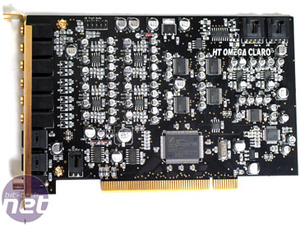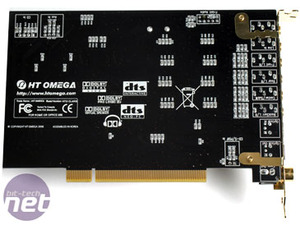Hardware
Essentially, the Claro's hardware is the same as the Inferno's. Both cards feature the following common components: the CMedia Oxygen HD processor, the Wolfson ADC, the CMedia CMI970 AC’97 codec and the AKM DAC’s. The only difference is that the Claro uses slightly different Op-Amps and is decked out completely with solid state capacitors.The contacts are all gold plated to provide maximum fidelity, and although they lose their identifiable colouring, they are still clearly labelled on the PCI bracket. The card uses a PCI interface, with the PCB coloured black. There's no indication as to whether a PCI-Express version is due in the future; it'll probably only happen when CMedia releases a chipset supporting the now two and a half year old interface.
The number of Internal connectors are also increased over what the Inferno offered. The Claro sports two CD inputs, a front panel audio connector and CD/coaxial S/PDIF input. Even though the digital CD input is quite unique, the coaxial S/PDIF in will arguably be used more.
There's a problem though: there's no way to route the supplied cable to the outside of your case for access, the card should provide a notch in the PCI backplate in order to allow the cable to pass through. In addition, having a cable dangling out the back of your case isn’t exactly the neatest option either.
- C-Media Oxygen HD CMI8788 Audio Processor;
- Four 24-bit / 192kHz AK4396VF (120dB SNR) DACs for 7.1 channel output;
- One 24-bit /192kHz WM8785G (110dB SNR) ADC input;
- One CMI9780 AC'97 2.3 CODEC for AUX input, CD input, MIC input (16-bit / 48kHz playback/recording)
- Integrated S/PDIF Optical and Coaxial connectors (both work simultaneously) for 44.1kHz,48kHz, 96kHz, 192kHz SPDIF input and output;
- Standard 10-pin Front Panel Audio connector supports stereo audio output and a microphone input;
- C-Media FlexBass™ - configurable LFE (low frequency effects) channel crossover frequency (from 50 to 250Hz);
- C-Media Magic Voice™, a feature for disguising your voice in online chatting;
- C-Media Xear3D™, 7.1 Virtual Speaker Shifter technology;
- C-Media Karaoke functions: Microphone Echo, Key-shifting;
- 10-band EQ for each channel;
- 27 global reverberation environments;
- 3D demos;
- Supports most industrial standards of 3D sound for PC gaming, including EAX™ 1.0 & 2.0, A3D™ 1.0 and DirectSound™;
- Supported operating systems: Microsoft Windows Vista (32-bit), Microsoft Windows 2000 Service Pack 3 (SP3), XP Service Pack 1 (SP1), Server 2003 SP1, XP Media Center Edition 2005 (MCE), Windows XP Pro x64 Edition.


MSI MPG Velox 100R Chassis Review
October 14 2021 | 15:04











Want to comment? Please log in.